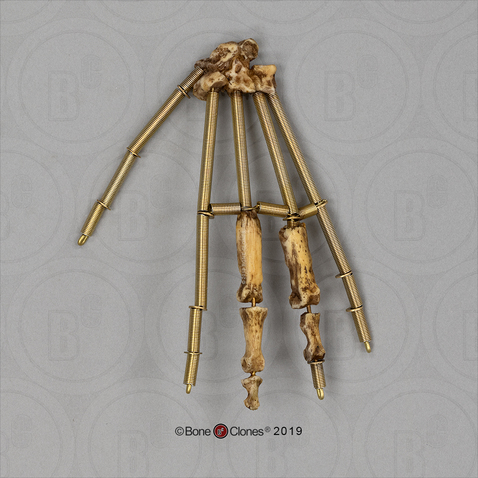-
Fields of Study
- K-12 Education
- Advanced Anatomy
- Forensics
- Physical Therapy
- Primate Locomotion
- Non-primate Locomotion
- Biological Anthropology
- Paleontology
- Bioarchaeology
- Marine-Aquarium
- Veterinary
-
Zoology
- All Zoological Items
- Endangered Species
- Skulls
- Skeletons
- Cranial Elements
- Postcranial Elements
- Eggs
- Limbs
- Teeth & Fangs
- Claws & Talons
- Brains & Endocasts
- Life Casts
- Pathology & Trauma
- Wildlife Forensics
- Sets
- Bird Sets
- Accessories
- Birds
- Mammals
- Reptiles & Amphibians
- Fish
- Sharks & Rays
- Turtles & Tortoises
- Anatomy for the Artist
- Decor
- Veterinary
- Elements
- Pathology & Trauma
-
Sets & Series
- Natural History Gift Ideas
- Decor
- Scale & Sculpture
- 3D Scanned & Printed
- Bone Boxes
- Locomotion Sets
- Forensic Sets
- Advanced Anatomy Sets
- Physical Therapy Series
- Fetal Sets
- Economy Series
- Zoology Sets
- Bird Sets
- Claw & Talon Sets
- Tooth & Fang Sets
- Primate Skull Sets
- Fossil Hominid Sets
- B.I.O.P.S.I. - Babiarz Institute
- Maxwell Collection
- Bergdorf Goodman Windows
- Accessories
- New Products
-
Our Company
- News & Specials
- Printable Handouts
- About Us
- Why Choose Bone Clones
- Bone Clones in the News
- Mission
- Contact Us
- Privacy and Security
- Frequently Asked Questions
- Testimonials
- Community Outreach
- Legal/Copyright
- Flyers
- Choosing Original Specimens
- Museum Exhibitions
- Natural History Gift Ideas
- About the Economy Series
- Acknowledgements
- Ordering & Delivery
- Warranty
- Refund/Return Policy
- Price List at a Glance
- Our Catalog
- Osteological Evaluation Reports
- About 3D Printing
- Sawyer & Maley Neanderthal Reconstruction
- Site Introduction
- Newsletter Archive
-
Human Anatomy
- All Human Anatomy
- Human Skulls
- Human Skeletons
- Head & Neck
- Postcranial Elements
- Advanced Anatomy
- Physical Therapy / Joints
- Human Brains & Endocast
- Human Life Casts
- Maxwell Museum
- Sets & Series
- Accessories
- Osteological Evaluation Reports
- Featured
- Adult Human Anatomy
- Adolescent Human Anatomy
- Child Human Anatomy
- Fetal Human Anatomy
- Fossil Hominids
-
Zoology
- All Zoological Items
- Endangered Species
- Skulls
- Skeletons
- Cranial Elements
- Postcranial Elements
- Eggs
- Limbs
- Teeth & Fangs
- Claws & Talons
- Brains & Endocasts
- Life Casts
- Pathology & Trauma
- Wildlife Forensics
- Sets
- Bird Sets
- Accessories
- Birds
- Mammals
- Reptiles & Amphibians
- Fish
- Sharks & Rays
- Turtles & Tortoises
- Paleontology
- Non-human Primates
- Forensics
All items sold on this website are replicas and are 1:1 scale unless stated otherwise. All Bone Clones® products are made in the USA. No real/natural bone is available on this site.
 ALSO SEE:
ALSO SEE:
- Homo floresiensis Skull (Flores Skull LB1)
- Homo floresiensis Hand, Disarticulated
- Homo floresiensis Foot, Articulated
- Homo floresiensis Foot, Disarticulated
Homo floresiensis Hand, Articulated
KO-395-A $330.00
Articulated left hand of Homo floresiensis. A disarticulated version of the hand, as well as other H. floresiensis products can be found here. Due to the fragmentary nature of the find, missing elements are indicated with brass parts.
At the time of its discovery, H. floresiensis was the subject of much debate centering on whether it is a new human species, a pathological Homo sapiens, or a case of insular dwarfism of a Homo erectus population. However, studies using cladistic and morphological analysis suggest that Homo floresiensis is a separate species from Homo erectus and may share a common ancestor with Homo habilis, challenging the notion that Homo erectus was the only hominin to leave Africa before Homo sapiens did so about 180,000yrs ago.
The entire upper limb skeleton of Homo floresiensis exhibits a mosaic of primitive and derived (more human-like) features, providing a glimpse of a hominin that existed on the Indonesian island of Flores some 90,000 to 50,000 years ago. The hand and wrist of H. floresiensis resemble a more primitive morphology than that of modern humans. Specifically, some of the bones of the wrist (the trapezoid, scaphoid and capitate) resemble those found in African apes and australopithecines. Additionally, H. floresiensis was found alongside evidence of stone flaking technology, supporting the hypothesis that hominins with primitive wrist morphology were able to make and use stone tools.
The Bone Clones® Fossil Hominid line is composed of discoveries from anatomically modern humans, archaic humans, early Homo, early hominins, and other hominids. The majority of the casts in this line have been recreated by our team of anatomical sculptors. Some are reconstructions made by anthropology professionals using fragmentary elements from original discoveries and extrapolating the missing parts from those (i.e. Neanderthal skeleton).
| Scientific Name | Catalogue # | Size | Price |
| Homo floresiensis | KO-395-A | 6" L x 4" W 15L x 10W (cm) | $330.00 |
Related Products:
-
 Homo floresiensis Skull (Flores Skull LB1)
Homo floresiensis Skull (Flores Skull LB1) -
 Neanderthal Hand Reconstruction
Neanderthal Hand Reconstruction -
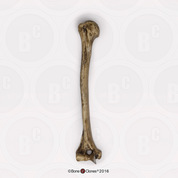 Neanderthal Humerus Reconstruction
Neanderthal Humerus Reconstruction -
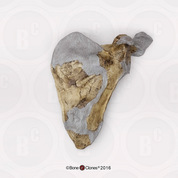 Neanderthal Scapula Reconstruction
Neanderthal Scapula Reconstruction -
 Ardipithecus ramidus Hand, Articulated
Ardipithecus ramidus Hand, Articulated -
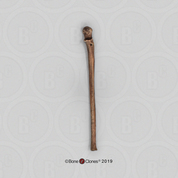 Homo ergaster Ulna KNM-WT 15000
Homo ergaster Ulna KNM-WT 15000 -
 Chimpanzee Hand in Knuckle-walking Pose on Brass Stand
Chimpanzee Hand in Knuckle-walking Pose on Brass Stand -
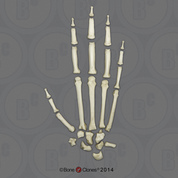 Bonobo Hand, Disarticulated
Bonobo Hand, Disarticulated -
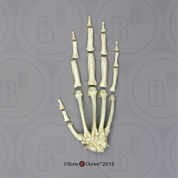 Male Chimpanzee Hand, Semi-articulated
Male Chimpanzee Hand, Semi-articulated -
 Fossil Hominid Tools set of 6
Fossil Hominid Tools set of 6 -
 "Lucy" Skeleton, Disarticulated
"Lucy" Skeleton, Disarticulated -
 Human Adult Female Hand, disarticulated
Human Adult Female Hand, disarticulated -
 Human Magnetic Hand, Right
Human Magnetic Hand, Right -
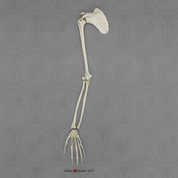 Human Male Asian Arm, Articulated with Scapula
Human Male Asian Arm, Articulated with Scapula -
 Human Male Asian Robust Arm, Disarticulated with Scapula
Human Male Asian Robust Arm, Disarticulated with Scapula
Newsletter Signup
9200 Eton Ave.
Chatsworth, CA 91311 USA
© 1992-2025 Bone Clones Holdings. All Rights Reserved.
Customer Service
© 2025 BONE CLONES HOLDINGS / Made by MEV




